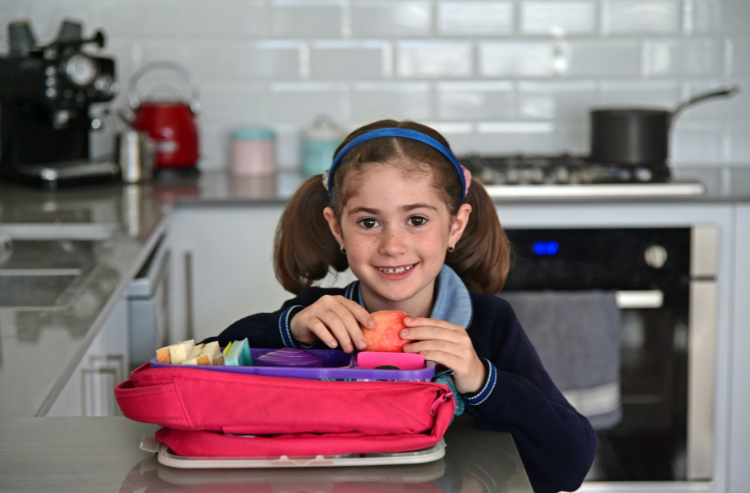Balanced and appealing lunchbox recipes

Creating balanced and appealing lunchbox recipes is essential for ensuring that children receive the nutrients they need for growth, development, and overall well-being. As children grow, their nutritional needs evolve, and providing them with a variety of foods that supply proteins, carbohydrates, healthy fats, vitamins, and minerals is crucial. A well-balanced lunchbox not only supports physical health but also enhances cognitive function, energy levels, and mood, all of which contribute to a child’s success in school and other activities.
To create a truly balanced lunchbox, it’s important to include a variety of food groups. Proteins are fundamental for muscle growth and repair, and they can come from sources like lean meats, eggs, beans, and dairy products. Carbohydrates, particularly from whole grains such as brown rice, whole wheat bread, and oats, provide sustained energy, which is critical for maintaining concentration and stamina throughout the school day. Healthy fats, found in foods like avocados, nuts, seeds, and olive oil, play a vital role in brain development and are essential for the absorption of fat-soluble vitamins like A, D, E, and K.
Vegetables and fruits are key components of a balanced lunchbox, offering a wide array of vitamins, minerals, and fiber. Fiber is essential for digestive health and helps keep children full, reducing the temptation to snack on less nutritious foods. Including a rainbow of fruits and vegetables not only makes the lunchbox more visually appealing but also ensures a broader range of nutrients. For example, including orange carrots for vitamin A, green spinach for iron and calcium, and red bell peppers for vitamin C can provide a well-rounded nutrient profile.
Making lunchboxes appealing to children is just as important as making them nutritious. Studies show that children are more likely to eat foods that are visually appealing and presented in a fun and engaging way. Bento box-style lunchboxes, which separate foods into different compartments, can make meals more inviting. Incorporating a mix of colors, shapes, and textures can entice children to try new foods. For instance, using cookie cutters to shape sandwiches or fruits into fun designs, or creating a “rainbow” salad with various colorful vegetables, can make healthy eating more enjoyable for kids.
Involving children in the preparation of their lunchboxes can also increase their willingness to eat balanced meals. When children help choose and prepare their meals, they are more likely to develop a positive attitude toward healthy eating. This involvement can be as simple as letting them pick out their favorite fruits or helping to assemble a sandwich. Research shows that children who are involved in meal preparation are more likely to consume fruits and vegetables and less likely to develop picky eating habits.
Balanced lunchbox recipes can also be tailored to accommodate dietary restrictions and preferences, ensuring that all children, including those with allergies or intolerances, receive the nutrition they need. For example, a child with lactose intolerance can be provided with a lunchbox containing lactose-free yogurt, fortified with calcium and vitamin D, paired with whole-grain crackers and a serving of fruit. Similarly, for a child with gluten intolerance, a lunchbox could include gluten-free wraps with lean protein, a side of fresh vegetables, and a piece of fruit. Customizing lunchboxes in this way ensures that all children can enjoy nutritious meals without compromising their health.
Moreover, the role of hydration should not be overlooked when planning balanced lunchboxes. Water is essential for all bodily functions, and ensuring that children drink enough water throughout the day is crucial for their overall health. Including a bottle of water in the lunchbox or offering milk alternatives fortified with vitamins and minerals can help maintain hydration and provide additional nutrients.
In the context of combating global malnutrition and obesity, balanced lunchbox recipes play a significant role. In developing countries, where access to nutritious food may be limited, lunchbox programs in schools can ensure that children receive at least one balanced meal per day, which can significantly improve their health outcomes. In developed countries, where childhood obesity is a growing concern, providing balanced, portion-controlled lunchboxes that focus on whole, unprocessed foods can help prevent excessive calorie intake and promote healthy eating habits.
Furthermore, educating parents and caregivers about the importance of balanced lunchboxes is essential. Providing them with resources, recipes, and tips on how to prepare healthy, appealing meals can empower them to make better food choices for their children. Schools and community programs can play a pivotal role in this education, offering workshops, cooking classes, and nutritional guidance to families.

Packing school lunches can be a fun and creative experience that excites kids about eating healthy. Use colorful containers and bento boxes to separate different foods, and include a variety of textures and flavors to keep things interesting. Cut sandwiches and fruits into fun shapes with cookie cutters, and add little notes or stickers for a personal touch. Mixing in dips like hummus or yogurt with veggies or fruits adds extra flavor and fun. With a little creativity, lunchtime becomes something kids look forward to, making them more likely to enjoy their nutritious meals.
To keep food fresh until lunchtime, it’s important to pack items in insulated lunch bags with ice packs to maintain a cool temperature, especially for perishable foods like dairy, meats, and fruits. Use airtight containers to prevent moisture loss and keep different food items separated to avoid cross-contamination. Pre-chill any beverages or perishable foods before packing, and consider using a thermos for hot items to retain heat. Wrapping sandwiches or cut fruits in wax paper or using a vacuum-sealed container can also help preserve freshness and prevent sogginess.
In conclusion, balanced and appealing lunchbox recipes are a powerful tool in promoting children’s health, supporting their growth and development, and preventing malnutrition and obesity. By ensuring that lunchboxes are both nutritious and enjoyable, parents and caregivers can help establish lifelong healthy eating habits in children, setting them up for a healthier, more successful future.
Here are 20 balanced and healthy lunchbox ideas that combine a variety of nutrients to support children’s growth and development:
1.Turkey and Avocado Wrap
A whole wheat tortilla filled with sliced turkey, avocado, lettuce, and tomato. Add a side of baby carrots with hummus and a small apple for a balanced meal rich in protein, fiber, and healthy fats.
2.Greek Yogurt Parfait
A serving of Greek yogurt layered with granola, mixed berries, and a drizzle of honey. Include a handful of nuts or seeds for added crunch and healthy fats.
3.Chicken and Veggie Stir-Fry
Brown rice topped with stir-fried chicken, broccoli, bell peppers, and snap peas. Include a side of orange slices for a boost of vitamin C.
4.Whole Wheat Pita with Hummus
Whole wheat pita bread cut into triangles and served with a side of hummus, cherry tomatoes, cucumber slices, and a small portion of feta cheese.
5.Quinoa Salad
A quinoa salad mixed with diced cucumbers, cherry tomatoes, black beans, corn, and a squeeze of lime juice. Add a side of sliced strawberries and a small piece of dark chocolate for dessert.
6.Cheese and Crackers
Whole grain crackers served with slices of cheddar cheese, apple slices, and a side of mixed nuts. Add a yogurt cup for extra protein and calcium.
7.Veggie and Cheese Quesadilla
A whole wheat quesadilla filled with shredded cheese, spinach, and diced bell peppers. Serve with a side of salsa and guacamole, and include a small bunch of grapes.
8.Mini Turkey and Cheese Roll-Ups
Turkey slices rolled up with cheese sticks, served with whole grain crackers, cucumber sticks, and a small serving of mandarin oranges.
9. Egg Salad Sandwich
A whole grain sandwich filled with egg salad, lettuce, and tomato. Pair it with a side of sliced carrots and celery sticks with ranch dip, and a small banana.
10.Pasta Salad
Whole wheat pasta mixed with cherry tomatoes, diced mozzarella, black olives, and a light Italian dressing. Include a side of apple slices and a small container of trail mix.
11.Tuna Salad Wrap
A whole wheat wrap filled with tuna salad, shredded lettuce, and cucumber slices. Add a side of cherry tomatoes and apple slices for a complete meal.
12. Bento Box with Rice and Chicken
Brown rice served with grilled chicken slices, steamed broccoli, edamame, and a side of pineapple chunks for a balanced, Asian-inspired meal.
13.Veggie and Hummus Sandwich
A whole grain sandwich filled with hummus, shredded carrots, spinach, and cucumber slices. Pair with a side of mixed berries and a handful of pretzels.
14.Turkey and Cheese Kabobs
Skewers of turkey, cheese cubes, cherry tomatoes, and cucumber slices. Serve with a side of whole grain crackers and a small container of yogurt.
15.Sweet Potato and Black Bean Burrito
A whole wheat tortilla filled with mashed sweet potatoes, black beans, and a sprinkle of cheese. Include a side of salsa and sliced kiwi.
16.PB&J on Whole Grain Bread
A classic peanut butter and jelly sandwich made with whole grain bread, served with carrot sticks, a hard-boiled egg, and a small clementine.
17.Spinach and Cheese Stuffed Pita
A whole wheat pita pocket stuffed with spinach, ricotta cheese, and a sprinkle of parmesan. Add a side of cucumber slices and blueberries.
18.Chicken and Veggie Skewers
Grilled chicken and vegetable skewers (bell peppers, zucchini, cherry tomatoes) served with a side of brown rice and a small bunch of grapes.
19.Turkey and Apple Sandwich
Whole grain bread filled with sliced turkey, apple slices, and a little Dijon mustard. Include a side of carrot sticks and a yogurt tube.
20.Veggie Sushi Rolls
Brown rice sushi rolls filled with cucumber, avocado, and carrot strips. Serve with a side of edamame and a small container of mandarin oranges.

